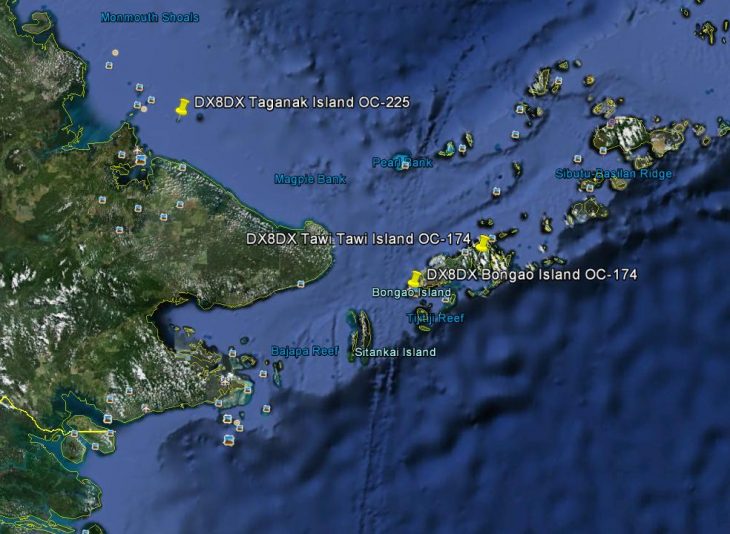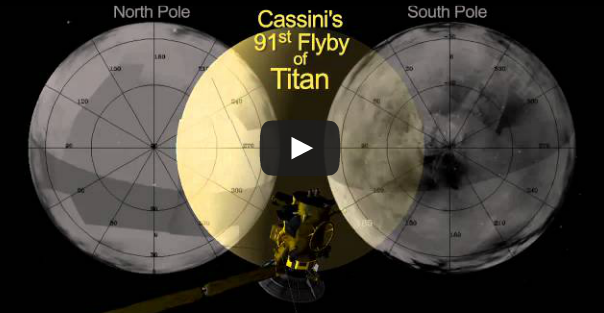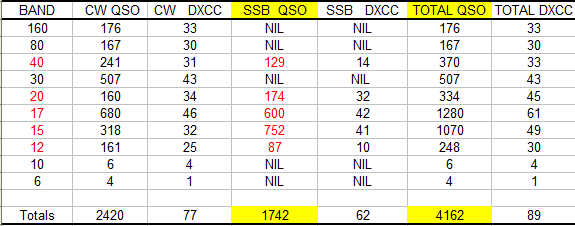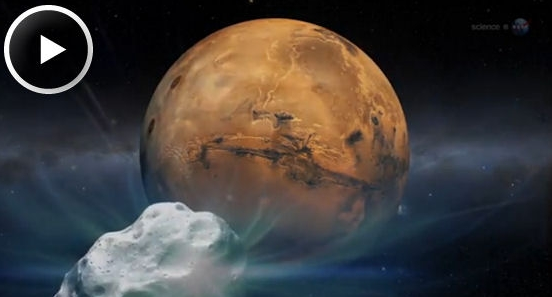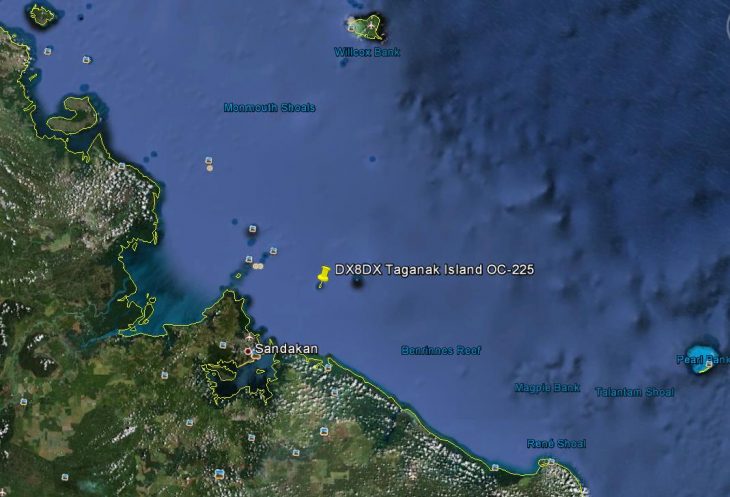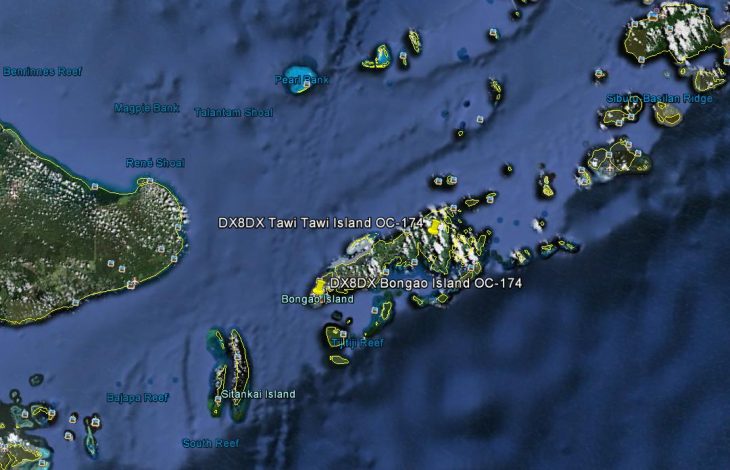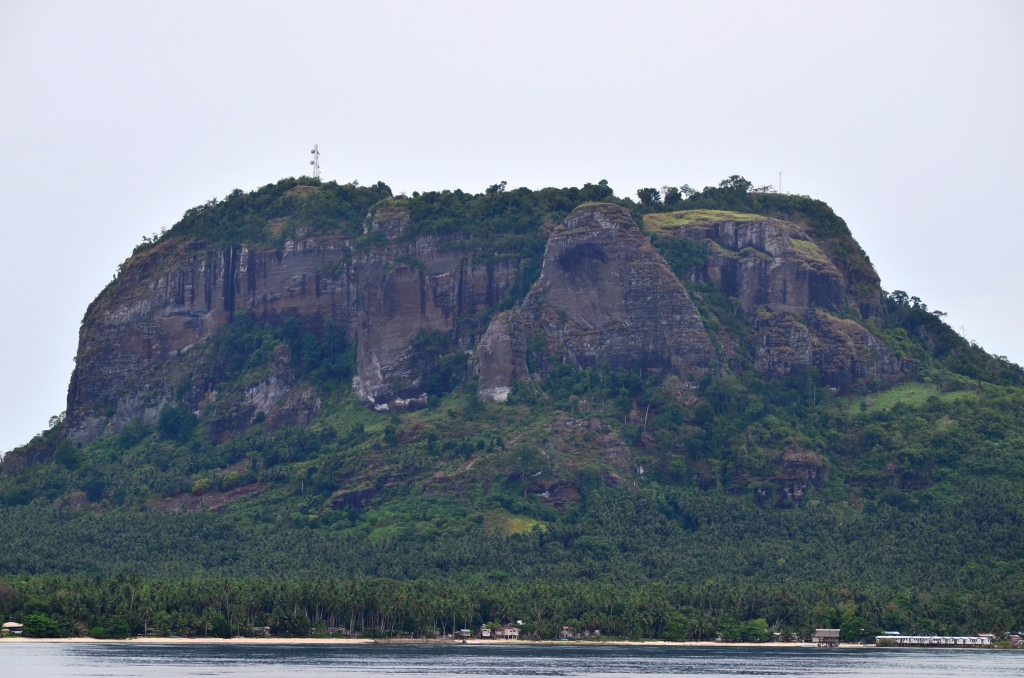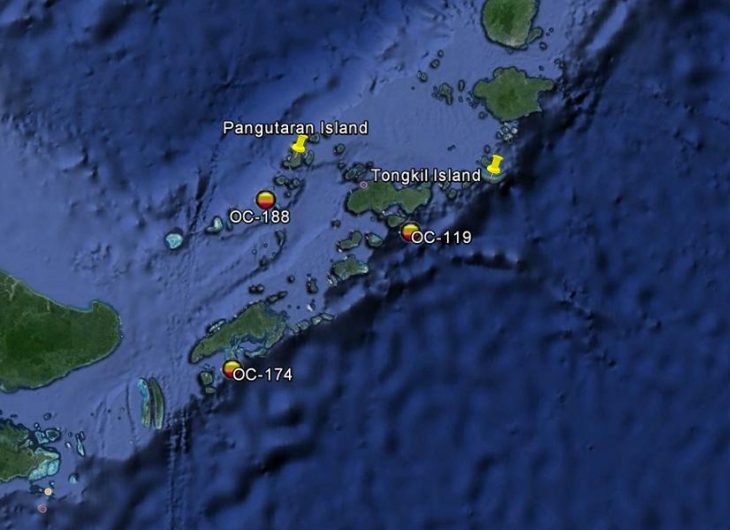DX8DX …blog and updates..
Tongkil Island (OC-119)(Cancelled) & Pangutaran Island (OC-188) ( 25th September 2014)
(I will update this Blog as and when I hear information from DX8DX)
30th September 2014 0445 UTC
DX8DX OC-188 log now received by Qsl Manager and Qsl Cards are printing.
27th September 2014 0150 UTC
DX8DX now QRT. A re-visit to this and other rare ones in DU is definite and when work commitments are not a factor. Thanks to all for your support.
26th September 2014 1355 UTC
There is NO Logsearch available for DX8DX. He is currently qrv 14020.00 QSX UP
26th September 2014 0330 UTC
Message from Dindo this morning with the disappointing news that he will be forced to qrt early. He will be qrv until early Saturday morning (27th, his local time) and then will have to leave the Island. This was always a possibility due to his employer but sad none the less. He will plan for another visit to this and/or other rare ones in the near future when ‘work’ is not a factor in his schedule.
25th September 2014 0310 UTC
Dindo has arrived on Pangutaran Island ahead of schedule, expect him to be qrv in the coming hours, good luck to all !
24th September 2014 1145 UTC
DV1UD (DX8DX) has arrived in Zamboanga city. He is now aboard a boat going to Jolo Sulu. May be
in Pangutaran (OC-188) earlier than scheduled.
22nd September 2014 1600 UTC
Dindo’s plans have changed which means he will be only able to activate one of the proposed Islands this time around. His hopes to make the crossing (between 12 and 18 hours depending on the Sea state) and hopefully be in Pangutaran by 26 September. He will remain there until the 3rd October. Of course I must again remind you that Dindo will be working intermittently throughout this period so operating will be sporadic periods but nevertheless as he is now there for a full week and that this is the rarest of the groups, we hope this will be a popular outcome for the IOTA chasers.
**Tongkil Island OC-119 cancelled**, ONLY Pangutaran Island OC-188 will be activated on this trip, see above.
19th September 2014 0530 UTC
Dindo updates that he still OK for the schedule. Work commitments will take priority so don’t expect him to be qrv constantly, he will take breaks to continue his work on the Island. Pangutaran Island (OC-188) will be given the priority and he will be listening hard. Dindo also asks for patience on the bands. If he takes time to work ”NA only” then please allow him to do so. He may be on the Island for more than a day so please observe the DX Code of Conduct!
16th September 2014 0900 UTC;
Dindo (DV1UD) will be qrv as DX8DX next week from Pangutaran Island IOTA OC-188 (Pangutaran Group) and Tongkil (Tongquil) Island IOTA OC-119 (Jolo Group)
Details are not exact at this stage but it is believed these activations will be around Thursday 25th and Friday 26th September 2014. Dindo has upgraded equipment this time around and will use Icom 706MKIIG (100w) and also K3 and KPA500 into Vertical antennas (SteppIR BigIR etc).
PREVIOUS ACTIVATIONS BELOW
Taganak Island (OC-225) & Bongao Island (OC-174) (MARCH 2013)
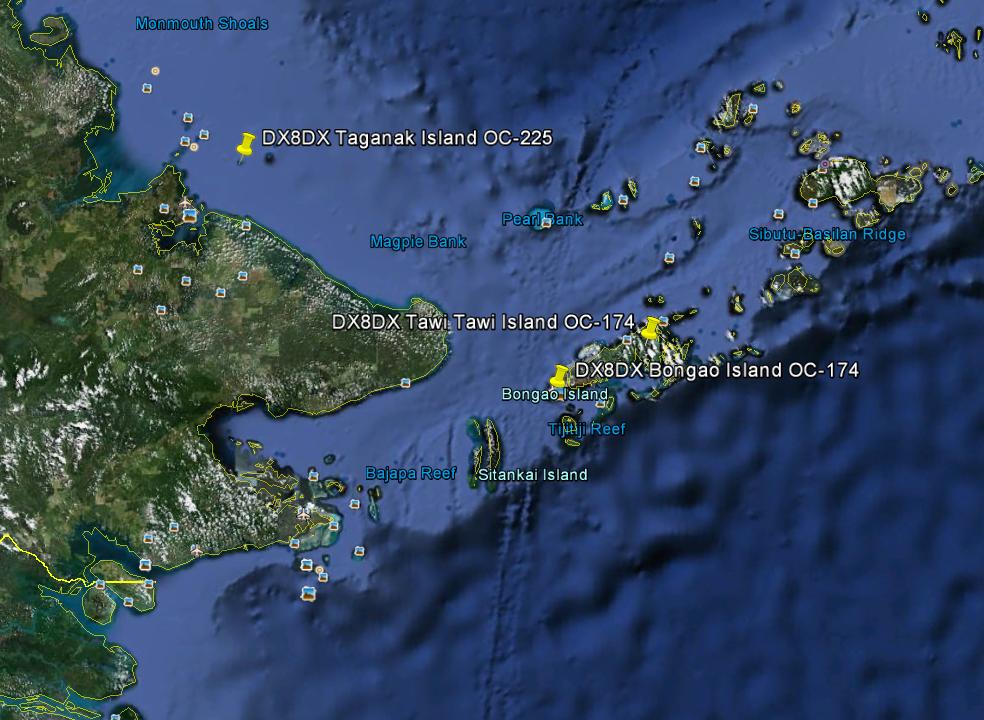
(Qsl information … scroll down)
(21st March 2013)
On 20th March 2013 and after several months of trying, Dindo DV1UD finally received the information
that he was being given permission to land on and activate three of the ‘most wanted’ Island in the DU area.
Dindo will visit Bongao Island (OC-174), Tawi-Tawi Island (OC-174) and Taganak Island (OC-225)
This is to complete some survey and research as part of his work requirements. His tentative schedule is for the first
week of April 2013. Hopefully this will allow him stay on each island for 2-3 days. He will grab this opportunity to activate
these rare IOTA’s between his work commitments.
(22nd March 2013) –
Equipment is Icom IC-7000, AH-4 Tuner and 100w into a Vertical Antenna.
Tentative departure from Manila is 02 April, and he expects to be in Bongao, Tawi Tawi by 04 or 05 April via Zamboanga City.
(26th March 2013) –
From Dindo DX8DX ”I am just waiting for confirmation re transportation as of now. Anyhow, looks like
it will be around 2nd or 3rd week as commercial transport is very limited in between the two IOTAs OC-174 and 225. CW will
be my preferred mode, averaging 24 to 30 wpm. I could adjust a little faster or slower, depending on the propagation
condition. I will publish my operating frequencies anytime soon. I will also operate split, and right now studying the
propagation from 80 to 6 meters locally. I will not be able to operate 160M…… 73 de Dindo DX8DX ”
(29th March 2013) –
From Dindo DX8DX ”Initially, I will be using these frequencies plus split, any changes of course I will
announce.
SSB: 3.755, 7.055, 14.280, 18.128, 21.260, 24.950, 28.460, and 28.560 MHz
CW: 3.530, 7.030, 10.115, 14.040, 18.098, 21.040, 24.920 and 28.040 MHz
My Icom IC-7000, AH-4, S9 vertical 33 ft etc are all setup already……….73 de Dindo DX8DX’‘
(2nd April 2013)
– From Dindo DX8DX – Hello all,
I got the call DX8DX approved already. Its validity is from 02 April to 31 May 2013. That means I have ample time to facilitate
transportation, which prove to be the most challenging part in this IOTA activation. As of now, the latest availability of
watercraft that would take me to Bongao, Tawi Tawi is on the 3rd week of April. After about a week of staying there will
proceed to Taganak Islands.
This are just part of the plan, as some part of this activity is beyond my control, I couldn’t give exact dates, but will inform
everyone thru this email of the latest updates.
Hope to hear you from the islands,
Dindo
DX8DX
(1820utc – 7th April 2013) – Dates confirmed as below
Hi All,
I am pleased to announce that Dindo DV1UD is now well on his way to the Islands for the activations.
He will be qrv as DX8DX (local conditions permitting) ;
from Bongao & Tawi Tawi (Tawi Tawi Group) (IOTA OC-174) – 09 to 11 Apr 2013
and Taganak Island (Turtle Island Group) (IOTA OC-225) – 13 to 15 Apr 2013
Please keep an eye on DX Cluster etc and also on this web page which will be updated as and when
information is received.
Thanks,
Charles MØOXO
(Qsl manager DX8DX)
(1415utc – 9th April 2013) – now QRV !!!
Dindo DX8DX now Qrv has now began txing from Bongao Island (Tawi-Tawi Group) IOTA OC-174.
He is currently working on 10115.00.
http://www.m0oxo.com/dx8dx.html
Good luck to all !!
73 de Charles MØOXO
(10th April 2013)
Photo’s from Island just received. http://www.m0oxo.com/681-dx8dx-qrv-oc-174.html
Dindo will be qrv again later today.
73 de Charles
( 1115UTC 10th April 2013)
DX8DX QRV on 30m now (10115)…..
(0415am 11th April 2013) – QRT from OC-174
from Dindo; ”Over 700 contacts for intermittent operation. I can not go for full time qrv as I have everyday report
deadline for work that consumes lots of my time. Thanks for all the contacts despite propagation
not too good for me. I am now QRT OC-174 and en route OC-225. I will have no contact from Taganak
so keep check on DX Cluster for when I am Qrv in two days time depending weather/sea conditions.
Thanks guys, 73 de Dindo”
(0415UTC 11th April 2013)
OC-174 Log received with thanks.
73 de Charles MØOXO
(0400UTC 12th April 2013)
Well as followers to the Blog will know, we expect activity fropm OC-225 tomorrow (13th). There was always an
outside chance he may be qrv later today (12th). Unfortunately its all guess work now as Dindo is out of contact
and we cannot exchange any messages at all. Lets hope he gets qrv before the Solar storm arrives tomorrow.
Pls check DX Clusters for when he appears. GL to all !
73 de Charles
(1006 UTC 12th April 2013)
DX8DX was spotted at 1004utc on 30m band, but it can not be confirmed yet if this was Dindo or a Pirate.
Please check back for any updated info.
(1300 UTC 12th April 2013)
…Now confirmed DX8DX OC-225 and running on 14042 split.
(0512 UTC 13th April 2013)
DX8DX Qrv for a second day from OC-225 and running on 12m CW
No details on the time he expects to qrt as yet?
(0410 UTC 14th April 2013) – QRT from OC-225
DX8DX QRT from OC-225
I will update this blog when the OC-225 Log is received and log checks welcome by email, see below.
Apologies for any inconvenience to Digimode users on 12m yesterday.
73 de Charles
(0400 UTC 16th April 2013)
OC-225 Log received, 1100 Qso’s logged. Log checks welcome by email (see below).
Dindo was qrv sporadically between 1003utc 12th April and last qso logged 0320 14th April. Any qso’s
outside these times were obviously not him.
Qsl card preparation has begun, and images from OC-225 will be here http://www.m0oxo.com/dx8dx/oc-225.html
later this morning.
Please also be aware that Paypal Qsl proceedure only works for Qsl requests. Any other amounts
you may wish to send as donations then please use the ”Donate” button top left of this screen. Thanks in advance.
73 de Charles
(17th April 2013)
OC-174/OC-225 both validated for IOTA claims, thanks G3KMA.
Qsl information via ;
OQRS (Direct or Bureau)
(click image below)
OR
Direct Mail (Direct)
(click image below)
Your Qsl Card is NOT required, please
DO NOT SEND it via the bureau use
OQRS
Please DO NOT send cards via the Bureau.
Logs will be uploaded to LOTW as soon as practicable after the operation.
Please remember that this is not a Dxpedition and on air time falls between breaks in his work schedule.
This page will be continually updated as news of other trips develop so please call
backand keep up to date with news of
DX8DX !!
images courtesy of Google Earth


